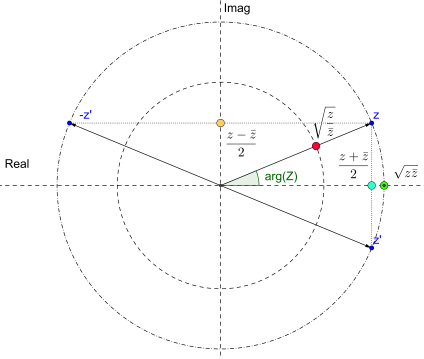Euler’s formula provides useful intuitions for understanding trigonometry identities, Fourier transforms, and complex analysis. To improve understanding and build robust mental models, it helps to relate fundamental principles in multiple and interesting ways. Below is part 1 of this series.
Complex Conjugate Relations to Magnitude and Phase
A complex variable , when transformed into polar coordinates on the complex plane (x-axis = real, y-axis = imaginary), can be expressed as a vector given by radius (magnitude or distance) and angle (phase or counter clock-wise rotation) components. The direct relations between the two domains is given as follows:
To further relate (magnitude, phase) and (real, imaginary) representations, it helps to introduce the complex conjugate which from a geometric view is the reflection of
over the real axis and equivalent to vector rotation in the clock-wise direction
. Applying basic arithmetic operations between
gives the following intuitions.

Geometry for arithmetic operations over complex and complex conjugate variables
Multiplication: (Real, Imaginary) ⇒ Magnitude
The algebraic product converts what was once the difference of squares into the sum of squares due to the sign inversion of the squared imaginary unit
. The geometric interpretation is the rotation of vector
back onto the real axis leaving only the magnitude component
.
Division: (Real, Imaginary) ⇒ Phase
The algebraic division makes use of the previous algebraic multiplication property for simplification. The geometric interpretation is the normalization of vector
onto the unit circle. This is more apparent when division is performed in the magnitude and phase representation given by
.
Addition: (Magnitude, Phase) ⇒ Real
The algebraic mean returns the real component and removes the imaginary component. The geometric interpretation uses Euler’s formula to relate the magnitude and phase components with the real component:
.
Subtraction: (Magnitude, Phase) ⇒ Imaginary
The algebraic difference returns the imaginary component and removes the real component. The geometric interpretation uses Euler’s formula to relate the magnitude and phase components with the imaginary component:
.